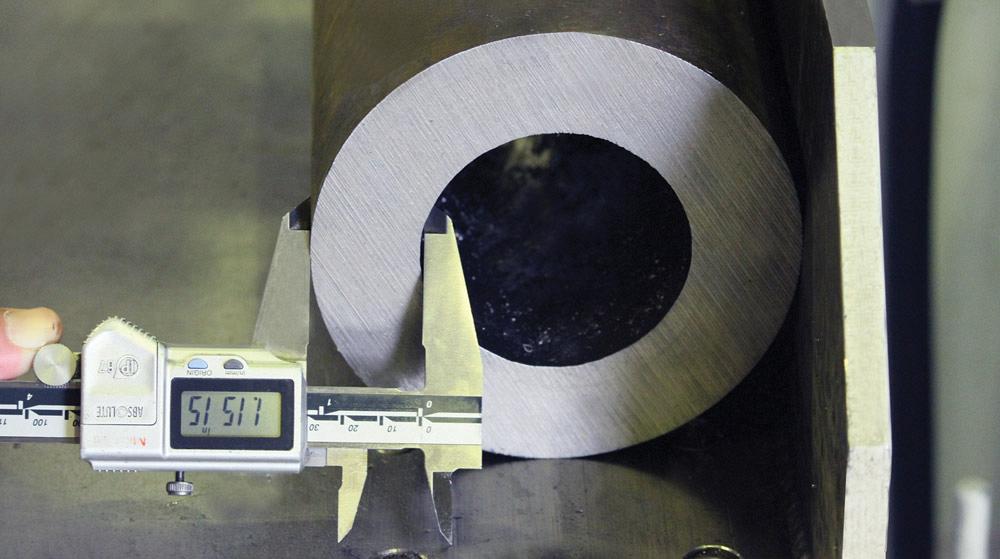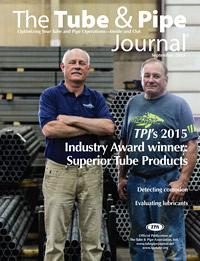- FMA
- The Fabricator
- FABTECH
- Canadian Metalworking
Categories
- Additive Manufacturing
- Aluminum Welding
- Arc Welding
- Assembly and Joining
- Automation and Robotics
- Bending and Forming
- Consumables
- Cutting and Weld Prep
- Electric Vehicles
- En Español
- Finishing
- Hydroforming
- Laser Cutting
- Laser Welding
- Machining
- Manufacturing Software
- Materials Handling
- Metals/Materials
- Oxyfuel Cutting
- Plasma Cutting
- Power Tools
- Punching and Other Holemaking
- Roll Forming
- Safety
- Sawing
- Shearing
- Shop Management
- Testing and Measuring
- Tube and Pipe Fabrication
- Tube and Pipe Production
- Waterjet Cutting
Industry Directory
Webcasts
Podcasts
FAB 40
Advertise
Subscribe
Account Login
Search
Oilfield components fabricator finds success in sawing heavy-wall tube
Band saw equipped with automatic loader, gripper increase throughput, accuracy in oil country
- By Eric Lundin
- August 24, 2015
- Article
- Cutting and Weld Prep
Conventional tube sawing may conjure images of relatively short, round pieces in which the wall thicknesses are about 5 to 10 percent of the tube’s OD. But what if the tubes are up to 26 feet long and the wall thicknesses equal the tube’s ID? Tri-Alta Oilfield Industries Ltd., Edmonton, Alberta, knows the answers. Tri-Alta manufactures submersible rod pumps, sucker rod, rod couplings, and accessories for oilfield applications. It processes thousands of feet of tube annually in its 24,000-sq.-ft. plant.
Tackling Tube Tasks
Tri-Alta’s world revolves around rigid API standards, which start with the material itself. For tubes, it’s a single material: ASTM A519-5, a mechanical grade of tube made from hot-finished bar having a minimum yield strength of 55,000 PSI and high tensile strength. With material this specific comes the challenge of supply. It is not uncommon for various combinations of lengths and thicknesses to be out of stock in oil country. This leads to alternative processing methods.
“If we can’t order tubing, we rely on plan B, literally making tube by drilling out shorter sections of solid bars under 12 in.,” said Chris Winter, Tri-Alta’s operations manager. Despite the premium cost of the purchased tube, plan B is still more expensive due to the extra time needed to process the bar and wear and tear on the machine.
After clearing the material sourcing and processing hurdles, the company faces cutoff challenges. Tri-Alta saws tubes that it manufactures as crossover collars, connectors, and other accessories for pumps and oil wells. Cuts need to be square and precise, often within ±0.032 in.
An interrupted cut can be difficult, but it’s all the more so when the wall thickness is up to 2.25 in. (see Figure 1). Thick walls generate excessive heat and stress. Considerable attention also needs to be given to speeds and feeds.
The result of these cutting difficulties is that the company routinely experienced tube sawing problems. Troubleshooting and remedying issues such as blade failure, inaccurate cuts, and part misalignment took up an increasing amount of time. Often members of the production team wasted three hours a day correcting sawing problems.
“We dealt with repeated blade failure, operator error, material loss, and especially time loss,” said Winter.
Stable Sawing and Strict Tolerances
After struggling with its old and ailing manual saw, the staff realized that it needed to increase the throughput and accuracy of the sawing operation.
Chad Tomlinson, Tri-Alta branch manager, attended a tradeshow where he saw a horizontal saw, one with an integrated material handling system, and was convinced it would solve their sawing problems. Six months later Tri-Alta purchased the system, a Behringer HBP 263A horizontal band saw equipped with an automatic chip conveyor, hydraulic bundle clamping system, and an inclined loading magazine.
The saw’s design is the key element. A large, dual-column design and a solid cast iron bow frame all but eliminate vibration, which is enemy No. 1 in any sawing operation. The band wheels also are cast, further enhancing the system’s rigidity. The dual-column design enables improved accuracy, smoother cut finishes, faster sawing, and longer blade life in that it applies uniform downfeed pressure across the blade and constant chip removal. The machine also has fully automatic hydraulic blade tensioning and carbide blade guides.

Figure 1
Hollow materials always present sawing challenges, mainly because every cut is really two cuts (known as an interrupted cut) as the
blade cuts through both walls. Heavy-wall tube exaggerates the stress on the blade. By the time the blade breaks through to the wall,
tooth strippage can occur at the material edge, resulting in blade failure.
Downfeed power and saw blade pressure are monitored by an automatic pressure-sensing system. This is especially helpful in interrupted sawing and situations in which the material thickness varies, both of which are common elements in cutting tube. Cutting pressure data is analyzed and the system automatically makes blade pressure adjustments as needed to ensure an optimal balance between feed rate and blade pressure. Operators can maximize material feed rates without concern of overloading the blade. Another contributing factor to the saw’s accuracy is the electronically controlled feed gripper, which positions the tube for cutting rapidly, before the gripper drifts away from the part, eliminating any drag against the tubes which could alter the measurement of the cut.
Reducing Sawing Time, Eliminating Headaches
Since the saw was installed, Tri-Alta has experienced a 50 percent reduction in man-hours, and operator error has been reduced by 80 percent. The company attributes these improvements to the saw’s precise cutting capability and the automated system features, both of which eliminate inaccurate cuts and misaligned parts. The company also has benefited from a greatly reduced scrap rate and an increased output of processed tube, owing to faster loading and faster sawing. Another bonus the manufacturer has realized is increased blade life, which in itself has translated into significant savings.
“Our new sawing operation cannot even compare to our old method,” said Tomlinson. “It’s like night and day. I only wish we had made the change sooner—it would have prevented a lot of headaches.”
About the Author

Eric Lundin
2135 Point Blvd
Elgin, IL 60123
815-227-8262
Eric Lundin worked on The Tube & Pipe Journal from 2000 to 2022.
About the Publication
Related Companies
subscribe now

The Tube and Pipe Journal became the first magazine dedicated to serving the metal tube and pipe industry in 1990. Today, it remains the only North American publication devoted to this industry, and it has become the most trusted source of information for tube and pipe professionals.
start your free subscription- Stay connected from anywhere

Easily access valuable industry resources now with full access to the digital edition of The Fabricator.

Easily access valuable industry resources now with full access to the digital edition of The Welder.

Easily access valuable industry resources now with full access to the digital edition of The Tube and Pipe Journal.
- Podcasting
- Podcast:
- The Fabricator Podcast
- Published:
- 04/16/2024
- Running Time:
- 63:29
In this episode of The Fabricator Podcast, Caleb Chamberlain, co-founder and CEO of OSH Cut, discusses his company’s...
- Trending Articles
Team Industries names director of advanced technology and manufacturing

3D laser tube cutting system available in 3, 4, or 5 kW

Corrosion-inhibiting coating can be peeled off after use

Zekelman Industries to invest $120 million in Arkansas expansion

Brushless copper tubing cutter adjusts to ODs up to 2-1/8 in.

- Industry Events
16th Annual Safety Conference
- April 30 - May 1, 2024
- Elgin,
Pipe and Tube Conference
- May 21 - 22, 2024
- Omaha, NE
World-Class Roll Forming Workshop
- June 5 - 6, 2024
- Louisville, KY
Advanced Laser Application Workshop
- June 25 - 27, 2024
- Novi, MI



























